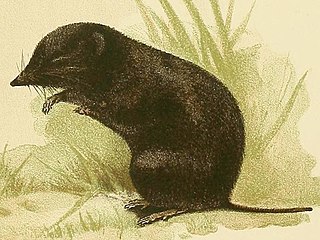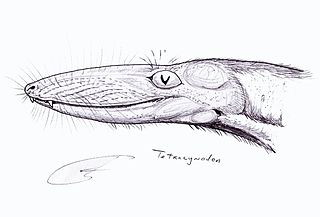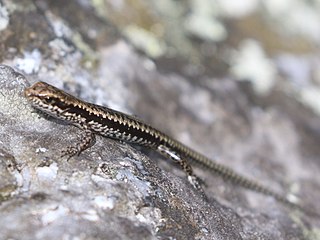
Pipistrellus is a genus of bats in the family Vespertilionidae and subfamily Vespertilioninae. The name of the genus is derived from the Italian word pipistrello, meaning "bat".

Mantoida is a genus of praying mantises in the family Mantoididae. The species of this genus are native to Mexico, Central America, and South America.
In linguistics, a tenuis consonant is an obstruent that is voiceless, unaspirated and unglottalized.

Nepenthes tenuis is a tropical pitcher plant endemic to the Indonesian island of Sumatra. The species was first collected in 1957, from a remote mountain in the western part of the island. It remained undescribed until 1994, and was only rediscovered in the wild in 2002. Prior to this, N. tenuis was known solely from a single photograph and dried herbarium specimen.
Schroederichthys is a genus of coloured catsharks in the family Atelomycteridae.

The least pipistrelle is a species of vesper bat.

Myosorex is a mammal genus in the Soricidae (shrew) family. The genus, collectively referred to as the mouse shrews, contains these species:

According to the current taxonomy, the Myosoricinae are a subfamily of shrews. As such, they form one of three main types of shrews, the other two being the red-toothed shrews and the white-toothed shrews. They are the only one of the three to be found exclusively south of the Sahara Desert, and so they have been described in English as the African shrews, but also many white-toothed shrews are in Africa and therefore this term is more generally used for shrews from Africa in general.

Cystopteris is a genus of ferns in the family Cystopteridaceae. These are known generally as bladderferns or fragile ferns. They grow in temperate areas worldwide. This is a very diverse genus and within a species individuals can look quite different, especially in harsh environments where stress stunts their growth. They hybridize easily with each other and identifying an individual can be challenging. In general these are rhizomatous perennials which grow in rocks or soil. Their leaves are multiply pinnate, in that each leaflet is divided into smaller parts. The sori are usually rounded and covered in an inflated bladder-like indusium.
Tenuis, weak or slender in Latin, and a species in zoology, may refer to:

Tetracynodon is an extinct genus of therocephalian. Fossils of Tetracynodon have been found in the Karoo Basin of South Africa. Two species are known: the type species T. tenuis from the Late Permian and the species T. darti from the Early Triassic. Both species were small-bodied and probably fed on insects and small vertebrates. Although Tetracynodon is more closely related to mammals than to reptiles, its braincase is very primitive and more resembles that of modern amphibians and reptiles than of mammals.
Helichthys is an extinct genus of prehistoric bony fish that lived during the Early Triassic epoch in what is now South Africa.

Archaeomaene is an extinct genus of freshwater ray-finned fish that lived in what is now Australia during the Late Jurassic. It is a monotypic genus, containing only the species Archaeomaene tenuis, which is known from the Talbragar River beds of New South Wales.

Psilactis is a genus of North American and South American plants in the tribe Astereae within the family Asteraceae which are known by the common name tansyaster. There are six species within the genus.

Trochita is a genus of sea snails, marine gastropod mollusks in the family Calyptraeidae, the slipper snails or slipper limpets, cup-and-saucer snails, and Chinese hat snails.
The thin sand-eel is an eel in the family Ophichthidae. It was described by Albert Günther in 1870, originally under the genus Ophichthys. It is a tropical, marine and freshwater eel which is known from the western Indian Ocean, including the Red Sea, South Africa, Mauritius and Réunion. Males can reach a maximum total length of 53 centimetres (21 in).

Rossodus is an extinct genus of conodonts in the clade Prioniodontida, the "complex conodonts", of the Early Ordovician.

Archaeomaenidae is an extinct family of stem-teleost fish found in freshwater environments of Jurassic New South Wales of Australia, China, and Antarctica, and in Lower Cretaceous New South Wales and Mongolia.

Concinnia is a genus of skinks in the subfamily Lygosominae.

Rupes Tenuis is a Martian north polar scarp. It is named after one of the classical albedo features on Mars. Its name was officially approved by IAU in 1988. It extends from latitude 74.94°N to 82.2°N and from longitude 242.12°E to 300.77°E. Its centre is located at latitude 81.6°N longitude 85.47°W. It marks the outer perimeter of Planum Boreum from longitude 242.12°E to 300.77°E, and it is formed by the eastern extension of the Olympia Cavi, a series of local troughs and depressions, which become longer and deeper as they merge to create the Rupes Tenuis scarp formation. The scarp is located to the west of Chasma Boreale, at the base of Planum Boreum, and its height varies from a few hundred metres to a maximum of approximately 1000 metres.













